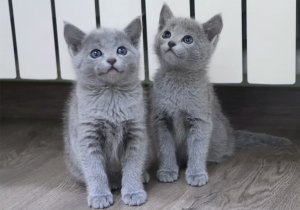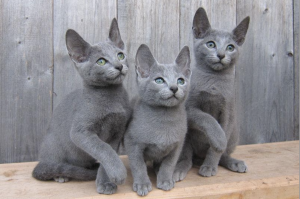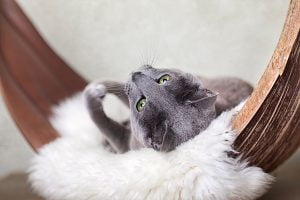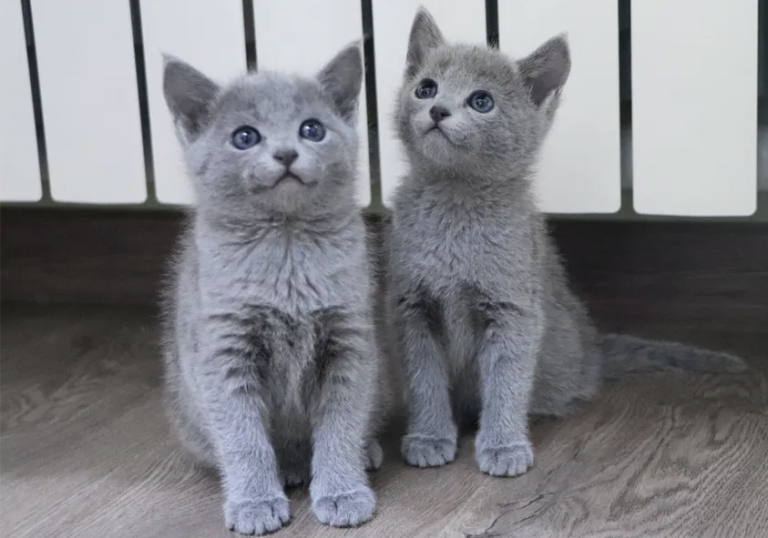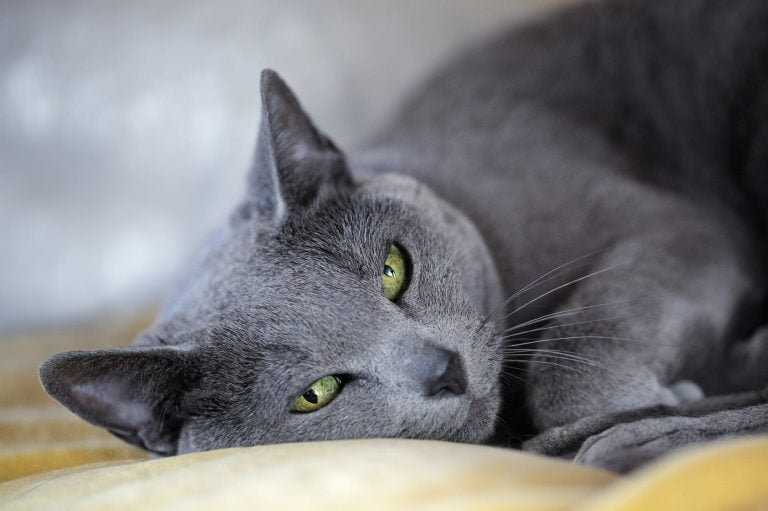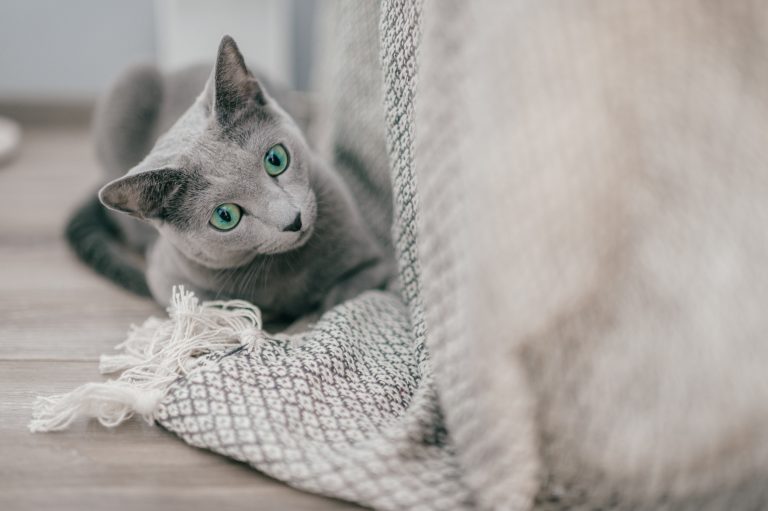Russian Blue cats are a fascinating and beloved breed that have captured the hearts of cat lovers all over the world. With their shimmering silver-blue coats and bright green eyes, they are as beautiful as they are intelligent and affectionate. But understanding their behavior can be challenging, especially for those who are new to the breed. By learning more about the behavior of Russian Blue cats, we can deepen our appreciation for these unique and wonderful felines, and provide them with the care and attention they deserve. In this article, we will explore the fascinating world of Russian Blue cat behavior and provide some tips and insights for anyone considering adopting one.

Personality Traits of Russian Blue Cats
Russian Blue cats are renowned for their striking appearance, with their shimmering silver-blue coat and bright green eyes. But it is their personality that truly sets them apart from other cat breeds. These felines are highly intelligent, curious, and playful, making them a joy to be around. They are also incredibly affectionate, and their gentle and calm demeanor makes them perfect companions for families with children or other pets.
Their intelligence makes Russian Blue cats highly adaptable, and they are often quick to learn new tricks and behaviors. They have a keen sense of curiosity, and love to explore their surroundings and engage in interactive play. They are also highly social cats, and thrive on human attention and interaction.
Their affectionate nature means that Russian Blue cats form strong bonds with their owners. They are often described as “velcro cats” due to their tendency to follow their owners around and seek out their company. They will often curl up on laps, purring contentedly, or snuggle up in bed with their owners. They are also highly attuned to their owner’s emotions and will often offer comfort and support when needed.
In addition to their playful and affectionate nature, Russian Blue cats are also known for their calm and gentle demeanor. They are rarely aggressive or temperamental, and will often respond to stress or conflict by retreating or seeking comfort from their owners. This makes them excellent pets for families with young children or other pets.
Overall, the personality traits of Russian Blue cats make them a beloved breed among cat lovers. Their intelligence, playfulness, and affectionate nature combine to create a feline companion that is both engaging and comforting. They are sure to bring joy and happiness to any household lucky enough to have them.

Socialization and Training of Russian Blue Cats
Early socialization and training are essential for ensuring that Russian Blue cats develop into well-adjusted and happy adults. As with all cat breeds, socialization involves exposing them to a variety of people, animals, and environments from a young age. This helps them become comfortable with new situations and reduces the likelihood of fear and aggression as they grow older.
Effective training techniques for Russian Blue cats include positive reinforcement and clicker training. Positive reinforcement involves rewarding good behavior with treats or praise, while ignoring bad behavior. This encourages cats to repeat good behavior, while discouraging bad behavior. Clicker training involves using a clicker to mark desired behavior, followed by a reward. This helps cats learn new behaviors quickly and easily, without the need for punishment.
Training Russian Blue cats can be a fun and rewarding experience for both the cat and their owner. These felines are highly intelligent and respond well to positive reinforcement techniques. They are also highly trainable, and can learn a variety of tricks and behaviors with consistent and patient training.
By socializing and training Russian Blue cats from a young age, owners can help ensure that they develop into confident and well-behaved adults. This will not only benefit the cat but also the owner, as a well-behaved cat is a joy to be around and can help strengthen the bond between cat and owner.
Communication and Body Language of Russian Blue Cats
Communication is a crucial part of any relationship, and this is no different for Russian Blue cats and their owners. These felines use a variety of vocalizations, body language, and scent marking to communicate with their owners and other cats. Understanding these communication cues can help owners develop a deeper bond with their cats and ensure that their needs are met.
Russian Blue cats use a variety of vocalizations to communicate, including meows, purrs, hisses, and growls. Each of these vocalizations can convey a different message, such as a meow for greeting or a hiss for warning. Paying attention to the tone and intensity of these vocalizations can help owners understand what their cat is trying to communicate.
Body language is another important communication cue for Russian Blue cats. They may use their tails, ears, and eyes to express their emotions and intentions. For example, a cat with a puffed-up tail and arched back may be feeling threatened or defensive, while a cat with relaxed ears and eyes may be feeling content and happy.
Scent marking is another way that Russian Blue cats communicate with other cats. They may use their scent glands to mark their territory, such as by rubbing their cheeks against objects or spraying urine. This helps other cats know that this is their space and can reduce the likelihood of conflict.
Understanding these communication cues can help owners develop a deeper understanding of their Russian Blue cat’s behavior. For example, a cat that is meowing loudly may be asking for attention or food, while a cat that is hissing may be feeling threatened or defensive. By paying attention to their cat’s body language and vocalizations, owners can ensure that their cat’s needs are met and that they are happy and comfortable.
Overall, the communication and body language of Russian Blue cats is complex and fascinating. By learning more about how they communicate, owners can develop a deeper bond with their feline companion and ensure that they are meeting their needs.
Play and Exercise for Russian Blue cats
Play and exercise are essential for the health and well-being of Russian Blue cats. These felines are known for their playful and energetic nature, and they require plenty of opportunities to engage in physical activity to stay healthy and happy.
Regular play and exercise can help keep Russian Blue cats physically fit and mentally stimulated. It can also help reduce stress and anxiety, as well as prevent obesity and other health problems.
There are many fun and engaging games and activities that Russian Blue cats may enjoy, such as:
- Interactive toys – toys that require cats to chase or hunt, such as laser pointers, feather wands, and puzzle feeders.
- Cat trees and scratching posts – these provide cats with a place to climb, scratch, and play.
- Hide-and-seek – this involves hiding treats or toys around the house for the cat to find.
- Agility training – setting up a simple obstacle course for the cat to jump over, crawl under, or weave through.
- Training sessions – teaching the cat new tricks, such as sitting, rolling over, or giving a high-five.
By providing plenty of opportunities for play and exercise, owners can help ensure that their Russian Blue cat stays healthy, happy, and well-adjusted. These felines are highly intelligent and playful, and they thrive on physical and mental stimulation.
Overall, play and exercise are essential components of a healthy and fulfilling life for Russian Blue cats. By providing fun and engaging activities for their feline companion, owners can help ensure that their cat lives a long and happy life.
Health and Behavior Issues in Russian Blue Cats
Like all cat breeds, Russian Blue cats can be susceptible to certain health and behavior issues. It’s important for owners to be aware of these issues and take steps to prevent or address them in a timely manner.
One common health issue that may affect Russian Blue cats is urinary tract problems. These felines may be prone to developing crystals or stones in their urinary tract, which can cause discomfort, pain, and even blockages. To prevent this issue, owners should provide their cats with plenty of fresh water, avoid feeding them dry food exclusively, and take them to the vet regularly for checkups.
Another common issue that may affect Russian Blue cats is separation anxiety. These felines are known for forming strong bonds with their owners, and may become distressed when left alone for long periods of time. To prevent this issue, owners can try gradually increasing the amount of time their cat spends alone, providing them with plenty of toys and activities to keep them occupied, and using pheromone sprays or diffusers to reduce stress.
Other behavior issues that may affect Russian Blue cats include destructive behavior, aggression, and fearfulness. These issues can often be addressed through positive reinforcement training techniques, such as clicker training and reward-based training. It’s important to seek the advice of a veterinarian or animal behaviorist if these issues persist or become severe.
By taking a proactive approach to preventing and addressing health and behavior issues in Russian Blue cats, owners can help ensure that their feline companion stays healthy, happy, and well-adjusted. With proper care and attention, these beautiful and intelligent cats can live long and fulfilling lives.
Conclusion
By understanding the behavior of Russian Blue cats, owners can develop a deeper bond with their feline companion, ensure their needs are met, and prevent or address any potential health or behavior issues.
For those considering adopting a Russian Blue cat, it’s important to research the breed thoroughly and understand the level of commitment required. These felines thrive on attention and interaction, and may require a certain level of play and exercise to stay healthy and happy.
For those who already own a Russian Blue cat, it’s important to continue to provide them with plenty of love, attention, and stimulation. Regular vet check-ups, proper nutrition, and a safe and comfortable living environment are also essential for their overall health and well-being.
In conclusion, Russian Blue cats are a wonderful breed that can bring a lot of joy and love to their owners’ lives. By understanding their behavior and providing them with proper care, owners can ensure that their feline companions live long, happy, and fulfilling lives.

